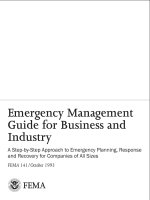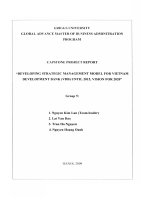Strategic management planning for domestic and global competition 14th ed pearce robinson chapter 12
Bạn đang xem bản rút gọn của tài liệu. Xem và tải ngay bản đầy đủ của tài liệu tại đây (285.46 KB, 32 trang )
Chapter 12
Leadership
and
Culture
© 2015 by McGraw-Hill Education. This is proprietary material solely for authorized instructor use. Not authorized for sale or distribution in any manner. This document may not be copied, scanned, duplicated, forwarded, distributed, or
posted on a website, in whole or part.
Learning Objectives
1.
2.
3.
Describe what good organizational leadership involves
Explain how vision and performance help leaders clarify strategic intent
Explain the value of passion and selection/development of new leaders in shaping
an organization’s culture
4.
Briefly explain seven sources of power and influence available to every manager
2
Learning Objectives (contd.)
5.
Define and explain what is meant by organizational culture, and how it is created,
influenced, and changed
6.
7.
Describe four ways leaders influence culture
Explain four strategy-culture situations
3
Organizational Leadership
•
The process and practice by key executives of guiding and shepherding people in
an organization toward a vision over time and developing that organization’s
future leadership and organization culture.
4
Strategic Leadership: Embracing Change
Telecommunications, computers, the Internet, and one global marketplace have
increased the pace of change exponentially during the past 10 years
The leadership challenge is to galvanize commitment among people within an
organization as well as stakeholders outside the organization to embrace change and
implement strategies intended to position the organization to succeed in a vastly
different future
5
Strategic Intent
•
Leader’s clear sense of where they want to lead their company and what
results they expect to achieve.
6
Clarifying Strategic Intent
•
•
Leader’s vision—an articulation of a simple criterion or characterization of what the
leader sees the company must become to establish and sustain global leadership.
Make clear the performance expectations a leader has for the organization, and
managers in it, as they seek to move toward that vision.
7
Leadership Development
•
The effort to familiarize future leaders with the skills important to the company and to
develop exceptional leaders among the managers employed.
8
Building an Organization
•
Perseverance (of a leader)
– The capacity to see a commitment through to completion long after most people would
have stopped trying.
•
Principles (of a leader)
– A leader’s fundamental personal standards that guide her sense of honesty, integrity,
and ethical behavior.
9
Shaping Organizational Culture
•
•
•
Passion, in a leadership sense, is a highly motivated sense of commitment to what
you do and want to do
Leaders also use reward systems, symbols, and structure among other means to
shape the organization’s culture
Leaders look to managers they need to execute strategy as another source of
leadership to accept risk and cope with the complexity that change brings about
10
Recruiting and Developing Talented Operational Leadership
New leaders will each be global managers, change agents, strategists, motivators,
strategic decision makers, innovators, and collaborators if the business is to survive and
prosper
Today’s need for fluid, learning organizations capable of rapid response, sharing, and
cross-cultural synergy place incredible demands on young managers to bring important
competencies to the organization
11
Competencies Leaders Should Possess (According to Ronald Riggio)
Broad Levels
• Self/personal leadership
• Interpersonal leadership
• Leading teams and organizations
12
Competencies Leaders Should Possess (According to Ronald Riggio) (contd.)
Competencies associated with each level:
• Self/personal leadership
• Self awareness
• Strong and positive character
• Sense of purpose
• Interpersonal leadership
• Ability to communicate
• Building and maintaining relationships
• Influence and motivation
13
Competencies Leaders Should Possess (According to Ronald Riggio) (contd.)
•
Leading teams and organizations
– Understanding and facilitating group/team processes
– Understanding organizational processes and dynamics
– Global mindset
14
Sources of Power and Influence
Organizational Power
•
•
•
•
Position power
Reward power
Information power
Punitive power
Personal Influence
•
•
•
Expert influence
Referent influence
Peer influence
15
Sources of Power Defined
•
Position Power
– The ability and right to influence and direct others based on the power associated with
your formal position in the organization
16
Sources of Power Defined
•
Reward Power
– The ability to influence and direct others that comes from being able to confer rewards
in return for desired actions or outcomes.
17
Sources of Power Defined
•
Information Power
– The ability to influence others based on your access to information and your control of
dissemination of information that is important to subordinates and others yet not
otherwise easily obtained.
18
Sources of Power Defined
•
Punitive Power
– Ability to attract and influence others based on your ability to coerce and deliver
punishment for mistakes or undesired actions by others, particularly subordinates.
19
Personal Influence Terms Defined
•
Expert Influence
– The ability to direct and influence others because they defer to you based on your
expertise or specialized knowledge that is related to the task, undertaking, or
assignment in which they are involved.
20
Personal Influence Terms Defined
•
Referent Influence
– The ability to influence others derived from their strong desire to be associated with
you, usually because they admire you, gain prestige or a sense of purpose by that
association, or believe in your motivations.
21
Personal Influence Terms Defined
•
Peer Influence
– The ability to influence individual behavior among members of a group based on group
norms, a group sense of what is the right thing or right way to do things, and the need
to be valued and accepted by the group.
22
Ex. 12.5 Management Processes and Levels of Management
23
Organizational Culture
•
Organizational culture is the set of important assumptions (often unstated) that
members of an organization share in common
•
•
Every organization has its own culture
Assumptions become shared assumptions through internalization among an
organization’s individual members
24
The Role of the Organizational Leader
•
The leader is the standard bearer, the personification, the ongoing embodiment of
the culture, or the new example of what it should become
•
How the leader behaves and emphasizes those aspects of being a leader become
what all the organization sees are “the important things to do and value.”
25









